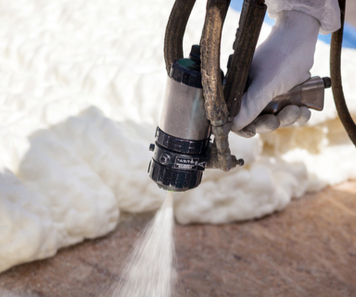Why Use Foam
The Best Insulation Product
What Is Spray Foam Insulation
Spray polyurethane foam (SPF) is a spray-applied plastic that can form a continuous insulation and air sealing barrier on walls, roofs, around corners and other surfaces. SPF insulation is known to resist heat transfer extremely well and offers a highly effective solution in reducing unwanted air infiltration.
Spray Foam is an Energy Efficiency Solution
As much as 40% of a building’s energy is lost due to air infiltration. Gaps, holes and air leaks can make energy bills unnecessarily high. Spray foam performs as both insulation and an air barrier, closing gaps that let air escape and add dollars to monthly energy bills. As much as half of the energy used in a home goes to heating and cooling, according to EPA. Maintaining an optimal heating, ventilating, and air conditioning (HVAC) system can make your home more energy efficient. With spray foam, HVAC sizing can be reduced as much as 35%. Air leaks that can waste energy and drive up utility bills can be filled with spray foam.
Some common spots for air leaks that can be sealed with spray foam include the area behind knee walls, attic hatches, wiring holes, plumbing vents, open soffits, recessed lights, furnace flue or duct chaseways, basement rim joists, windows and doors.



Closed-Cell Spray Foam Can Improve Building Strength and Durability
Applying an SPF roofing system can improve a building’s strength. In fact, SPF roofs have effective life spans that can exceed 30 years. SPF can help create a strong bond to protect the roof and can eliminate water seepage through weak spots. It can also be applied in a sloped manner to allow water to easily drain off the roof.
The bond that SPF forms can increase a building’s resistance to wind uplift. During periods of high wind, a building with a spray foam roof generally experiences less damage than a building without SPF. One prominent spray foam technical consultant notes that “when added to the inside of a structure, spray foam ‘glues’ the whole building together, enhancing overall wind and pressurization resistance.
SPF insulation adds strength and resilience. The Federal Emergency Management Agency (FEMA) has classified SPF insulation as highly resistant to floodwater damage, saying, “These materials can survive wetting and drying and may be successfully cleaned after a flood to render them free of most harmful pollutants.”
Spray foam prevents moisture and condensation throughout the building, helping prevent mold and mildew. Applying closed-cell spray foam in the cavities of the walls increases durability of the wall system because of its ability to conform and adhere to the surface upon which it is sprayed. A wall with spray foam insulation is better able to maintain its shape under duress than a wall assembly without spray foam.
Spray Foam and the Indoor Environment
SPF can make your home or building more comfortable in many ways. Spray foam helps minimize airborne sound transmission. Sealing a building’s air leaks prevents drafts, creating a more comfortable indoor environment and providing better indoor temperature control. Closed-cell spray foam acts as a barrier to water and vapor, helping to prevent condensation and water intrusion. Sealing gaps with spray foam can provide a barrier against pollen, dust and insects, which can be especially helpful in households with allergy sufferers. Spray foam helps minimize airborne sound transmission.
Frequently Asked Questions
There are many myths and misconceptions regarding Spray Foam Insulation as a product. This section is dedicated to answering the most common questions we get regarding our services.
